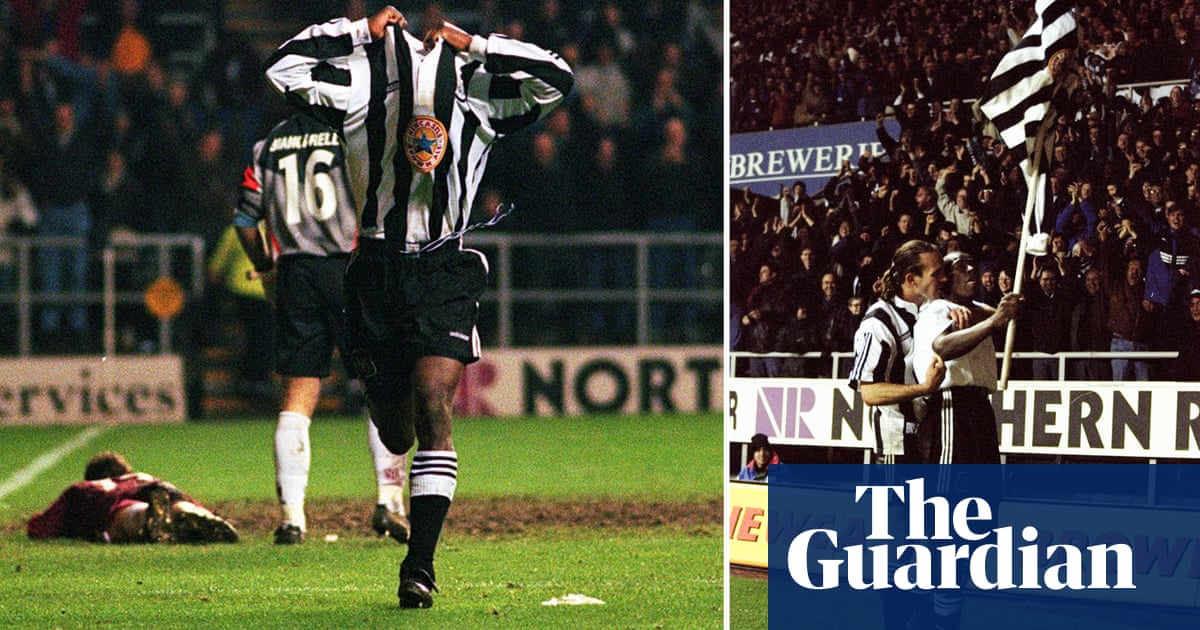
“Who was the first player to score on Christmas Day?” asks Sarah Tomlinson.
For a long time, matches on Christmas Day were a regular part of the English Football League calendar. The first was played on 25 December 1889, when the defending champions Preston beat Aston Villa 3-2 in an, ahem, ding-dong match. The opening goal was scored after six minutes by Preston’s Scottish striker Nick Ross, which makes him the first man to score in the Football League on Christmas Day.
We don’t think he’s the first to score in a competitive match, though. A year earlier, Everton played two games on Christmas Day: a Lancashire Cup game against Blackburn Park Road, followed by an exhibition game against Ulster FC. The opening goal – or “point” as it was called in most newspaper reports – was scored by a Blackburn Park Road forward listed only as “Gargett”. “Mackereth centred, and Gargett scored with a real beauty,” read the Liverpool Mercury report. “This point was deservedly obtained, and roused great cheering.” Everton went on to win 3-2.
But if we take a look at Christmas Day fixtures in Scotland, there was a scorer eight years earlier. There were three Scottish Cup Games on 25 December 1880 but, given that live score apps didn’t exist 143 years ago, the details are not so easy to nail down for sure. What we have found out it is that Rangers v Dumbarton and Arthurlie v Vale of Leven were both goalless at half-time, but Campsie Central v Queen’s Park was a one-sided goalfest. A report on qphistory.com has Queen’s Park running out as 10-0 winners with goals for George “Geordie” Ker (3), John Smith (3), Johnny Kay (2) and Harry McNeil (2).
So, assuming that order is chronological and Ker scored first, he is the first-ever footballer to find the back of the net in a competitive game on Christmas Day. And if it’s not, then a tip of our festive party hat to one of the other three listed scorers.
Knowledge archive special
“I vaguely remember waking up on Boxing Day morning a couple of years ago (with a massive hangover) and seeing a caption on Football Focus with an old list of Boxing Day fixtures and an awful lot of goals. Was it something to do with the DTs or did this really happen?” wondered Ken Davro in 2000.
We’re not doctors, so our lawyers advised us to make no comment about the floating spots in front of your eyes. But we can help you with the Boxing Day thing. On 26 December 1963, an amazing 66 goals were scored in the old First Division, leaving some teams wishing there had been a repeat of the previous season’s Big Freeze (which had wiped out nearly all the football between Boxing Day and March). Here are the classifieds:
Blackpool 1-5 Chelsea
Burnley 6-1 Man Utd
Fulham 10-1 Ipswich
Leicester 2-0 Everton
Liverpool 6-1 Stoke
Nottm Forest 3-3 Sheffield Utd
West Brom 4-4 Tottenham
Sheff Wed 3-0 Bolton
Wolves 3-3 Aston Villa
West Ham 2-8 Blackburn
If that wasn’t weird enough, the results two days later – when many of the teams played the “return leg” – beggar belief. West Ham, who had lost 8-2 at home to Blackburn, won 3-1 at Ewood Park. Manchester United, fresh from a 6-1 thrashing at Burnley, turned the tables at Old Trafford with a 5-1 win. And poor Ipswich, who had clearly been on the Christmas Day pop, avenged their 10-1 defeat by Fulham with a 4-2 victory over the Cottagers at Portman Road. Much good the two points did them, mind you: they finished bottom.
“Do you know which football club opened its ground for ice-skating because the pitch was frozen?” asked Kim Vanderhoven back in 2004.
The year was 1962-63, and England and Wales were experiencing their coldest winter since 1740 (Scotland, incidentally, was suffering its worst since 1829). From Boxing Day 1962 to early March 1963, most of the British Isles were under snow, with temperatures five to seven degrees below average.
Not surprisingly, hardly any football was played. Indeed, the winter was so severe that Barnsley only managed two games from 21 December 1962 to 12 March 1963. Up the road in Halifax, however, they hit upon an enterprising idea: why not use the Shay for ice-skating?
Ironically, it happened on 2 March 1963 when – as the Manchester Guardian booklet “The Long Winter 1962-63” reports – most of the country was, at long last, experiencing a thaw:
Troops relieved a farm on Dartmoor which had been cut off by 20ft snow drifts for 66 days. With only 14 Football League matches postponed, soccer had its best day for 11 weeks. There was still no football at Halifax, but the local club opened its ground as a public ice rink and hundreds skated on it.”
The stunt pulled in a few pennies, but it didn’t do Halifax any good – they scraped only 30 points all season and were relegated to the fourth division, along with Carlisle, Brighton and Bradford Park Avenue.
“Has any club ever been cruel enough to give their manager the boot on Christmas Day?” wondered Simon Briggs in 2006.
Heartless as it sounds, a club has been known to sack its manager on Jesus’s birthday, and they were even brave enough to ruin the festivities for one José Mário dos Santos Mourinho Félix. “I was nine or 10 years old and my father [Félix] was sacked on Christmas Day,” recalled the Chelsea manager, during an interview back in 2004. “He was a manager, the results had not been good, he lost a game on 22 or 23 December. On Christmas Day, the telephone rang and he was sacked in the middle of our lunch.” Mourinho Jr has come close to a festive firing himself – he was sacked by Chelsea on 19 December 2015, and by Manchester United on 18 December 2018.
Can you help?
“When Rico Lewis made his England debut against North Macedonia, he became the fourth England full-back in recent history to be born in Bury, Greater Manchester (joining Gary Neville, Phil Neville and Kieran Trippier). Given that the population of the town is only 81,000 (the wider borough has 193,000 people), this seems to be a very impressive record. Are there any other ‘small towns’ that have provided players for particular positions in the England (or any other national) team more consistently?” wonders Michael Barlow.
“I follow the Swedish women’s top division, OBOS Damallsvenskan, and couldn’t help but wonder at the distance between the top and bottom half of the table this season, which saw Hammarby clinch the title,” begins Jonas Jacobson. “Early on there appeared to be a big gulf in class between the seven best teams and the seven in the bottom half, and the distance between seventh-placed FC Rosengård (champions in 2022) and eighth-placed Växjö DFF (newcomers from the second tier) was 19 points. So, naturally, I wondered: has there ever been a bigger gap between the top and bottom half of a first division table?”
“Patrick Kisnorbo was recently fired at Troyes. During his coaching tenure, his record was W3 D14 L23, a meek 7.5% win record, and led his club to be relegated to Ligue 2. Yikes. Barring caretaker managers (I’d say 10 fixtures minimum), does he hold the title of worst manager in the ‘Big Five’ leagues?” mails Florian Labrouche.
“Over the weekend in Malta, a Brazilian player, André Carlos Penha da Costa, who plays for second-tier Melita FC, scored his second consecutive four-goal haul for the club (in five days),” writes Jean Pierre Attard. “I was wondering if there is some sort of record for such a feat? I understand the most consecutive hat-tricks is five.”












